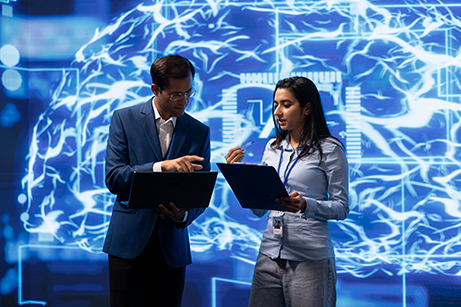AIMC Topic: Hernia, Ventral
Clear Filters Showing 1 to 10 of 34 articles
Fairness of machine learning readmission predictions following open ventral hernia repair.
Surgical endoscopy
Jul 7, 2025
INTRODUCTION: Few models have predicted readmission following open ventral hernia repair (VHR), and none have assessed fairness. Fairness evaluation assesses whether predictive performance is similar across demographic groups, ensuring that biases ar...
Deep learning model utilizing clinical data alone outperforms image-based model for hernia recurrence following abdominal wall reconstruction with long-term follow up.
Surgical endoscopy
Jun 11, 2024
BACKGROUND: Deep learning models (DLMs) using preoperative computed tomography (CT) imaging have shown promise in predicting outcomes following abdominal wall reconstruction (AWR), including component separation, wound complications, and pulmonary fa...
Operative efficiency: a comparative analysis of Versius and da Vinci robotic systems in abdominal surgery.
Journal of robotic surgery
Mar 22, 2024
Robotic-assisted surgery has gained momentum in the pursuit of improved minimally invasive procedures. The adoption of new robotic platforms, such as the Versius, raises concerns about safety, efficacy, and learning curves. This study compares the Ve...
How Appropriate Are Recommendations of Online Chat-Based Artificial Intelligence (ChatGPT) to Common Questions on Ventral Hernia Repair?
Journal of laparoendoscopic & advanced surgical techniques. Part A
Feb 14, 2024
ChatGPT is a conversational AI model developed by OpenAI to generate human-like text based on the input it receives. ChatGPT has become increasingly popular, and the general public may use this tool to ask questions about different medical conditions...
Feasibility of Image Inversion for Ventral Hernia Repair Using the Versius System.
Journal of laparoendoscopic & advanced surgical techniques. Part A
Dec 6, 2023
The aim of our technical report is to demonstrate the image inversion technique in the new Versius Robotic System. We report a step-by-step surgical maneuver for robotic surgeons when performing robotic ventral hernia repair (VHR) with the Versius ...
Short-term outcomes after open versus robot-assisted repair of ventral hernias: a nationwide database study.
Hernia : the journal of hernias and abdominal wall surgery
Nov 30, 2023
PURPOSE: The robotic platform is widely implemented; however, evidence evaluating outcomes of robotic ventral hernia repair is still lacking. The aim of the study was to evaluate the short-term outcomes after open and robot-assisted repair of primary...
The use of a porcine model to teach advanced abdominal wall dissection techniques.
Surgical endoscopy
Nov 13, 2023
BACKGROUND: In the era of minimally invasive surgery, it is clear that a robust simulation model is required for the training of surgeons in advanced abdominal wall reconstruction. The purpose of this experimentation was to evaluate whether a porcine...
Short-term Outcomes After Laparoscopic IPOM Versus Robot-assisted Retromuscular Repair of Small to Medium Ventral Hernias: A Nationwide Database Study.
Annals of surgery
May 22, 2023
OBJECTIVE: To examine the short-term outcomes after laparoscopic intraperitoneal onlay mesh (IPOM) compared with robot-assisted retromuscular repair of small to medium-sized ventral hernia.
Robotic Versus Laparoscopic Ventral Hernia Repair: Two-Year Results From a Prospective, Multicenter, Blinded Randomized Clinical Trial.
Annals of surgery
May 19, 2023
OBJECTIVE: Report the 2-year outcomes of a multicenter randomized controlled trial comparing robotic versus laparoscopic intraperitoneal onlay mesh ventral hernia repair.
Comment to "From transabdominal to totally extra-peritoneal robotic ventral hernia repair: observations and outcomes".
Hernia : the journal of hernias and abdominal wall surgery
May 17, 2023
Popular Topics
- Machine Learning 31964
- Neural Networks, Computer 30201
- Algorithms 27375
- Deep Learning 26880
- Artificial Intelligence 24818
- Robotics 13382
- Image Processing, Computer-Assisted 9730
- Retrospective Studies 9328
- Magnetic Resonance Imaging 6341
- Reproducibility of Results 5670
- Tomography, X-Ray Computed 4863
- Support Vector Machine 4762
- Computational Biology 4328
- Brain 4125
- Computer Simulation 3932
Recent Journals
- Scientific reports 6689
- Sensors (Basel, Switzerland) 4794
- PloS one 4186
- Neural networks : the official journal of the International Neural Network Society 3026
- Computational intelligence and neuroscience 1931
- Computers in biology and medicine 1915
- Annual International Conference of the IEEE Engineering in Medicine and Biology Society. IEEE Engineering in Medicine and Biology Society. Annual International Conference 1686
- Studies in health technology and informatics 1378
- IEEE journal of biomedical and health informatics 1167
- Journal of chemical information and modeling 1059
- Nature communications 1029
- Computer methods and programs in biomedicine 883
- Bioinformatics (Oxford, England) 872
- Journal of medical Internet research 853
- Briefings in bioinformatics 853
